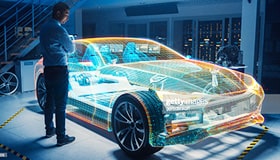Wireless power transfer: a convenient and efficient solution for EV charging
Introduction
In recent years, there has been a notable transition towards electric modes of transportation, driven by advancements in technology and the growing preference for environmentally-friendly means of travel. Electric vehicles (EVs) face two significant challenges that set them apart from fossil fuel-powered cars, namely the charging process and range anxiety. Existing charging infrastructure requires lengthy waiting periods at public charging stations or household outlets. To promote the widespread use of electric vehicles, a dependable and efficient charging infrastructure is necessary. One such solution is wireless power transfer, which has the potential to be a game-changer for the electric vehicle industry.
Wireless Power Transfer (WPT) technology allows EVs to charge wirelessly when in motion or stationary. It offers a more efficient and cleaner way to transfer power without wires, cords, or plugs. WPT works on the principle of magnetic induction.
Figure 1 shows two coupled coils - the core components- of the WPT system. The transmitter (source) and the receiver (load) allow power transfer via a magnetic field. The transmitter converts electrical energy into a form that can be transmitted wirelessly, and the receiver captures the energy and converts it back into electrical power.

Figure 1: Magnetically coupled IPT
L1, L2: Primary and the secondary coils
C1, C2: Compensation capacitors
M: Mutual inductance
WPT systems can be grouped under three main categories considering the mode in which power transfer can take place:
- Magnetic coupling: It is based on inductive power transfer (IPT). It is the most popular method of wireless transfer as it has longer transfer distances.
- Capacitive coupling: It is based on a confined electric field distribution between two conductive plates. It lags behind a few limitations on transfer distance and power levels.
- Microwave propagation: Power transfer occurs with low efficiency using high frequencies (300 MHz to 300 GHz) over long distances. These are adverse for EVs application due to the effects of electric fields in the human body.
Among the WPT charging technologies, Inductive power transfer (IPT) provides promising merits for EVs. Wireless chargers based on IPT systems can be tightly coupled electromagnetic (Non-Radiative), loosely coupled (Radiative) and Uncoupled radio frequency (RF) chargers. IPT technology is galvanically isolated, does not contain any moving parts, noise-free, tolerates relatively large misalignments, and is capable of transferring high-power through a relatively large air-gap (10–40 cm), which fits the ground clearance for most of the vehicles. WPT can be implemented using different types of coil designs, a few of them are Circular, Bipolar, Flux pipe/flat solenoid, Tripolar, Zigzag, etc.
Advantages of using wireless EV charger
- WPT reduces driver involvement in the charging process and offers a safe environment for the consumer because the charger does not need to be plugged into the car. This addresses safety-related concerns such as an electric shock.
- WPT can offer a completely automated charging system, making it simpler for consumers to charge their vehicles automatically.
- WPT charging infrastructure can help reduce the battery pack size and correspondingly make the EVs more efficient.
- Wireless EV chargers offer increased safety compared to wired chargers, as there's no risk of electric shocks or fires from exposed cords.
- It delivers higher charging speeds and enhances safety.
- Wireless EV chargers are built to be highly durable and reliable. They can withstand extreme weather conditions and be used in areas with limited access.
- Wireless EV chargers are compatible with most electric vehicle models and there is no need to upgrade the charger when you buy a new vehicle.
Wireless EV charging can be either static or dynamic
- Static charging: An EV can be recharged by static charging when it is parked for a long time i.e. it is in a stationary position.
- Wireless charging: This is charging on the move and is an alternative to stationary charging, which can be termed as a dynamic wireless charging method. The primary recharging coils are buried under the road and connected with high-voltage, high-frequency magnetic fields. The secondary coil is attached underneath the vehicle, which will recharge the EV battery whilst the vehicle is being driven.
Quasi-dynamic charging is a part of the dynamic method, which increases driving range along the route with charging stations installed at bus stops and traffic light intersections suitable for public transportation vehicles, especially EV buses.
Static charging
Figure 2 depicts the static wireless charging block diagram. The ground component and the vehicle side - onboard component make up the two sections that comprise the charging structure. The amount of induced voltage depends on the air gap length between these coils, the number of turns and the value of dφ/dt; φ is the magnetic flux.

Figure 2: Static wireless charging system
In a typical setup, the transmitter coil is buried underground whilst the receiving coil is underneath the vehicle. The ground infrastructure comprises an AC/DC converter, a DC to AC converter block which converts high-frequency DC voltage into a time-varying magnetic field, and a compensation network that matches the coupling coefficient of the primary and secondary coil. This helps in transferring power with high efficiency. The receiver coil, compensation network, AC/DC converter, and battery management system form the onboard component on the vehicle side. The source compensation minimises the reactive power and eliminates the phase difference between the current and voltage. Additionally, the load power transfer and efficiency are maximised by secondary compensation.
The energy is transferred to the receiver coil by activating the transmitter coil with the transmitter converter. The received energy is then converted to DC using a rectifier, which is subsequently used to charge the EV battery. The DC-DC converter controls the battery charging process.
Dynamic charging
In a dynamic IPT system, electric vehicles can be charged whilst in motion, eliminating the need to stop or wait for charging to complete. Using a Dynamic Wireless Electric Vehicle Charging System (D-WEVCS) helps address challenges related to EV range and cost. This system includes transmitter and receiver (vehicle side) power pads and two magnetically coupled isolated coils. Based upon vehicle load constraints, the road is divided into potential segments with the same length to determine which segments will be occupied by a dynamic wireless charging system (DWCS). The long-track coils can be divided into multiple sub-tracks to avoid unwanted leakage EMF. Each sub-track can be activated and deactivated by supplying them through a switch box fed by an HF inverter.

Figure 3: Segmented pad configurations with switch breaks
The system can be configured in various ways, such as using a single high-frequency (HF) power supply to feed multiple transmitter pads in series or parallel or using lower HF power supplies to power each transmitter pad individually. As shown in figure 3, the voltage at the 50 Hz AC bus is stepped up to reduce transmission loss. Then, before the segmented transmitters, the voltage is stepped down via the inverter. Constant current is also used at the transmitters. In the segmented pad configuration shown in Figure 3(a), each segmented pad can operate independently using a magnetic coupler connected to a bidirectional AC switch that turns "on" or "off" the power pad. This allows for individual maintenance of each segmented pad without affecting the regular operation of the remaining system. Figure 3(b) illustrates a configuration that uses a two-turn transmitter pad track, where the current direction in one of the turns can be changed using switch boxes to turn "on" or "off" the magnetic fields in a specific segmented pad.
Conclusion
Applying WPT for charging an EV during movement is a feasible solution for solving the limited driving range of EVs. Few of the WPT technologies are explained along with the importance. Static Charging finds application in designs where the electrical loads must be stationary during the wireless powering. Dynamic wireless power transfer allows the load to be mobile during power transfer in electric vehicles. The system can be a single transmitter track or a segmented transmitter coil array.
Stay informed
Keep up to date on the latest information and exclusive offers!
Subscribe now
Thanks for subscribing
Well done! You are now part of an elite group who receive the latest info on products, technologies and applications straight to your inbox.
Related Article
- Charging protocols and safety standards for EV Charging Infrastructures
- The Future of EV Infrastructure: Navigating trends, opportunities, and benefits
- A Developer's Guide for designing the EV Charging using the right tool
- Revolutionizing Electric Vehicles - Innovations in Motor Control Systems
- How to implement Smart Metering in EV charging
- How to design an efficient power conversion circuit for EV Chargers
- Transforming Mobility: The Architecture and Solutions of V2X Communication in Electric Vehicles
- The effects of electric vehicle charging stations to the power grid
- Cyber security of public charging stations
- Powering Up with Safety and Ease: The Art of EV Charger Design
- EV Charging Standards: Ensuring Compatibility and Safety in the Charging Process
- EV charging and renewable energy for sustainable transportation
- EV Charging and Battery Management System
- Wireless Power Transfer: A Convenient and Efficient Solution for EV Charging
- Design Considerations for High-Efficiency EV Chargers
- The benefits and challenges of electric vehicles
- Communication network for electric vehicle charging
- How to boost Level-3 EV charging with the right connectivity
- How SPI isolated communication helps BMS in EVs








